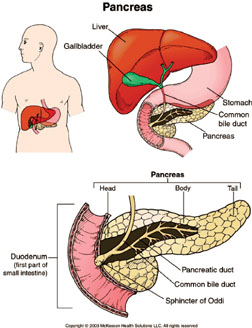
Pancreas: An efficient organ in your stomach
Have you ever heard the word, pancreas? Well, if you are not certain
what that means, today we will discuss the pancreas, which is a gland in
the abdomen that produces enzymes and hormones.
The pancreas produces digestive juices (enzymes) that continue the
process of breaking down foods, which begins in the stomach. The
pancreas also produces hormones, most famously insulin, which controls
the balance of glucose between the blood and the rest of the body.
Thanks to the pancreas, the body can use the sugars and store the fats,
which are essential for health.

The pancreas looks like a flat, elongated tadpole, and is about 6-10
inches (18-25 cms.) long. It lies behind the stomach in the upper
abdomen. Its broadest part, called the head, is attached to the
duodenum, which is the loop at the top of the small intestine. The
stomach empties already partially digested food and liquid into the
duodenum and it is here that it mixes with the secretions from the
pancreas.
The main part of the pancreas, the body, extends leftwards and
slightly upwards, narrowing towards a tail. The pancreas can also be
compared to a stalk, with clusters of grapes attached to it. It has a
duct running through its length, which is joined by many small branches
from the glandular tissue. This duct joins another duct bringing bile
from the liver, and a single duct then opens into the duodenum.
The pancreas is composed of two main types of tissue. Most of this is
known as exocrine tissue which produces pancreatic enzymes - a litre
(2.2 pints) or more every day - which aids digestion. If insufficient
enzymes are produced, serious malnutrition can result, even though
enough high quality food is being eaten.
Embedded throughout the mass of exocrine tissue are the grape-like
clusters of hundreds of thousands of endocrine cells, known as islets of
Langerhans. These produce two main hormones which regulate pancreatic
secretions and control blood glucose, the body's fuel.
The pancreas is an amazingly efficient, self-regulating organ, far
cleverer than any machine ever invented. Day in, day out, throughout a
lifetime, a healthy pancreas produces exactly the right chemicals at the
right times, in the right quantities, for digesting the food we eat.
As soon as food enters the duodenum, the pancreas begins its biggest
job, which is to secrete from its exocrine tissue the clear, watery,
alkaline juice, containing enzymes that help break down food into
molecules small enough to be absorbed by the intestine.
* Two of these enzymes, trypsin and chymotrypsin digest proteins.
* The enzyme amylase breaks down carbohydrate foods.
* Another enzyme, lipase, breaks down fats, into smaller molecules
called fatty acids and cholesterol.
The two main hormones produced by the endocrine tissue are insulin
and glucagon. Insulin is secreted when the blood sugar is raised and
causes the muscles and other bodily tissues to take up glucose from the
blood to fuel their activity. Insulin also promotes the absorption of
glucose into the liver, where it is stored as glycogen for use, in
response to stress or exercise.
Glucagon is released from the pancreas when the blood sugar is low.
Its main effect is on the liver to cause the break down of glycogen (the
stored form of glucose) into glucose, which is released into the blood,
thus restoring the level to normal.
How do you maintain a healthy pancreas? To a great extent, the
pancreas looks after itself, so the rules are really quite simple.
Maintain a sensible, balanced diet, do not smoke and avoid drinking in
excess.
Chamitha Kuruppu |


